The best time and task management tool, the Eisenhower Time Management Matrix organises and priorities tasks into two equal, related attributes – importance and urgency – to help a person get more work done and increase their productivity.
The two qualities came from a speech Dwight D. Eisenhower delivered in the early 1950s: “I have two kinds of problems, the urgent and the important. The urgent are not important, and the important are never urgent.” If you don’t recognise Eisenhower’s name, he probably knew a thing or two about important and urgent tasks as he was both the 34th President of the United States and a five-star general during WWII to boot.
Stephen Covey took Eisenhower’s quote and introduced his version of the time management matrix in his most well-known book, The Seven Habits of Highly Effective People (1989). Part of the tool’s effectiveness – also known the Eisenhower Box, the Eisenhower Method, or simply the Urgent-Important Matrix – is the simple way it helps the user divide their tasks into four basic categories.
Quick Overview of the Matrix
Einsenhower’s two aspects – importance and urgency – form the basis of the time management theory, creating four distinct quadrants.
1. High Importance and High Urgency: Tasks to Do First
2. Low Importance and High Urgency: Tasks to Schedule for Later
3. High Importance and Low Urgency: Tasks to Delegate or Reconsider
4. Low Importance and Low Urgency: Tasks to Delete or Do Last
Modern variations of time management have adapted the categories slightly, so I’ve added additional points and considerations to each of the four quadrants.
It’s also proven to be adaptable to “old school methods” such as a paper-based activity or to “new school methods” such as digital devices and apps.
Click any button below to jump to a quadrant for more detail. Use the blue arrow in the bottom right corner to return to the top of this page.
Each Quadrant, with Examples and Notes
#1 - High Importance and High Urgency (Tasks to Do First)
Mantra: “Do it now, as best as possible”
These are critical activities in time management. Make them a priority and do them now.
Tasks in this box require you to be both flexible and immediately reactive.
These tasks should be rare – particularly if you are generally well-planned.
Confusion over a task’s importance (vs. its urgency) can push some tasks into this box.
Remember, importance is always more important than urgency.
Prioritise tasks that fall into this category according to their relative urgency.
- If two or more tasks appear equally urgent, discuss and probe the actual requirements and deadlines with the ‘task originators’ (your supervisor for example) or with the people dependent on the task outcomes.
- You may need to help the originators of these demands to re-assess the true urgency and priority of these tasks.
- If helpful, you should show your schedule to task originators in order to explain that you are prioritising in a logical way, and to be as productive and effective as possible.
- Look for ways to break a task into two stages if it’s an unplanned demand. For example, provide a suitable initial “holding” response or acknowledgment, followed by a commitment to resolve or complete at a later date. This might enable you to resume other planned tasks.
Examples
- Unexpected meeting with a client
- Memo from boss demanding immediate attention
- Phone call / email from the media
- Safety issues
- Personal or family crisis
- Product quality has been compromised
- Senior management wants something
What about crises? Fire fighting?
In terms of crises, some are completely unexpected. More often, they are a mixture of problems which may have been avoided with better planning (yours or others). If this is the case, get to the root of the poor planning. If you are a manager and are constantly dragged into dealing with crises materialising from others, you may need to deal with them through training. Again, try to examine the root causes and deal with them specifically. Don’t allow a task from another quadrant to jump into this box.
If you are planning an agenda …
Projects or tasks in this High Importance/High Urgency quadrant should directly link to the purpose of the meeting, and should be discussed as soon as possible on the agenda.
Items in this quadrant typically involve the key decision makers.
Unless you have excessive time, focus on fewer items in this category than more. Or, prioritise the these items in case time is lost on discussion and debate.
Make sure you have enough time after the meeting or presentation for discussion and debate.
#2 - High Importance and High Urgency (Tasks to Schedule for Later)
Mantra: “Plan to do, with adequate attention, resources and time”
These tasks are most critical to your success as they support your overall/annual goals, KPIs or similar objectives.
For many people, tasks in this quadrant often are neglected because they are not urgent.
Tasks here require planning, research, analysis and strategic and creative thought – all crucial for development and success.
More so than other tasks, items here require defined and specific time slots, where you are free from interruptions, especially tasks from Quadrant #1 or #3 which try to take precedence. Work from home, for example, and inform others so you can be assertive.
Having a visible schedule is kiey to being able to protect these vital time slots.
Break big tasks down into separate and logical stages.
Be future-oriented – otherwise, you might have problems later. In fact, any tasks left long enough without thought or reflection become yet another task for Quadrant #1.
Examples
- Mid- to long-range planning, preparation or scheduling
- Developing change, direction, strategy
- Research, investigation, designing, testing
- Thinking, creating, modelling, designing
- A concerted, direct effort
- Big projects by end of week
- Items which you need others’ input, or ones which you may need to remind others
- Networking relationship building
- Systems and process development
- Anticipation and prevention
When planning an agenda …
Projects or tasks in this High Importance/Low Urgency quadrant are long-range or long-term assignments that will – at some point – become urgent as the deadline looms.
These tasks typically need someone else to comment, collaborate or provide information, such as a person from a different department or outside the company. Many times, this person is a subject matter expert.
It’s often best for the group to delegate the task (or divide into smaller tasks) to a smaller group or individual to handle, oversee and report back.
When do you place them on the agenda? My experience tells me that it’s best to schedule a planning meeting – not a status meeting – to give these soon-to-be-important items the attention they deserve.
(By the way, there are seven different types of meetings. Go here if you’re interested.)
#3 - Low Importance and High Urgency (Tasks to Delegate or Reconsider)
The goal is to reduce items in this quadrant by number, by length or by frequency.
The mantra then has three options:
- “Reject diplomatically and explain” or
- “Delegate” or
- “Spend as little time as possible on these tasks”
These are tasks with close deadlines, so much of your daily activity will come under this heading.
These tasks tend to be jobs indirectly related to your goals, but are generated by others. You’re essentially helping someone else do their job, at the expense of your own.
Do not spend (much) time on tasks not connected with your goals.
Tasks in Quadrant #3 often …
- Seem easy to deal with, so you do them first. Or, they may seem justified because they’re work related. Remember, it’s the timing – not the content – that is inappropriate.
- Are ones you enjoy, so you spend too much on them.
- Are ones you do because they’re difficult to avoid, and you don’t want to appear rude.
Scrutinise any potential task in Quadrant #3 ruthlessly, even if it’s from your boss or senior managers. You will have three options:
- Reject, but explain why. Be transparent and sensitive. If the originator persists, scrutinise and probe demands. Work with the originator to re-assess.
- Delegate to someone else.
- Spend as little time as possible on these tasks. The key with items in this quadrant: they should command the smallest amount of your time, so make sure you understand what is required and do not exceed that requirement.
You will need to put these tasks into your diary for completion ahead of the deadline and plan to give them as little time as possible.
Be creative. Help the originator find another way of achieving what they need, which might involve delegation to another person, or re-shaping the demand to be more strategic, with a more sustainable solution.
Look for causes of repeating demands in this area and seek to prevent re-occurrence. Educate and train others to identify long-term remedies, not just quick fixes.
Examples
- Trivial requests from others
- Ad-hoc interruptions, hi-jacking, apparent emergencies and distractions (“Got a minute?”)
- Sudden crises from a forgotten or misplaced tasks (a call, an e-mail)
- Misunderstandings appearing as complaints
- Pointless routines, activities and gossip
- Accumulated unresolved trivia
- Boss’s whims or tantrums
When planning an agenda …
Projects or tasks in this Low Importance/High Urgency quadrant are tasks which need fast responses or directives, but are often random one-off assignments. Many times, it involves someone – before this meeting, after this meeting – sending an e-mail, making a phone call, going to … er, another meeting. These tasks should be discussed at the end of the agenda, if you have time – or at the beginning of the agenda if you feel like you can cover them without debate so you can get to the #1 tasks. Or, consider if they might be managed before or immediately after the meeting and not discussed at all on the agenda.
#4 - Low Importance and Low Urgency (Are these really tasks?)
Mantra: “Resist” or “Cease” or “Do after everything else”
Leave these tasks alone in time management until you have time or less urgent needs.
Many items in Quadrant #4 are done just for fun (playing a quick game of Wordle) as they are neither important nor urgent.
Easier to manage this quadrant at home than at work.
In your work environment, you may be subject to a task that’s part of your “job description” but doesn’t necessary help achieve your goals. If it may interfere with a more important task, talk with a senior person about how to manage.
Examples
Time wasters
- Meetings of little to no relevance to you
- Long-term projects not yet properly defined, or may never happen
- Embellishment and over-production
Trivia tasks: things to avoid, but things also you may end up doing just to get them out of the way
- “Comfort activities” (computer games, net surfing, gossip, social activities, daydreaming, doodling, reading non-relevant materials)
- Minor office tasks, such as opening mail, reading publications cover to cover, certain memos, cc:Mail requests
Other activities in this area may be non-productive tasks without a positive outcome, which means they’re likely to be demotivating. Avoid them if you can.
Some of these tasks may be stress related. Consider why you’re going these tasks. Is there a deeper problem to examine?
Be aware that some activities here may be trivial now but may simmer and increase in temperature, becoming Quadrant #1 activities.
If nothing comes of a task in this quadrant after a reasonable period of time, it can probably be binned.
When planning an agenda …
Projects or tasks in this quadrant are often long-term projects which have not yet been properly defined, are tasks which are being lobbed into your jurisdiction to handle, or (more realistically) are projects which may never happen at all.
Be strict about this category. Do you want to waste valuable meeting time on these, or do they deserve to be delegated to an individual to oversee until an element of the tasks changes?
Have you used the Time Management Matrix in the past? What other systems have you used? Please add your thoughts and comments below.
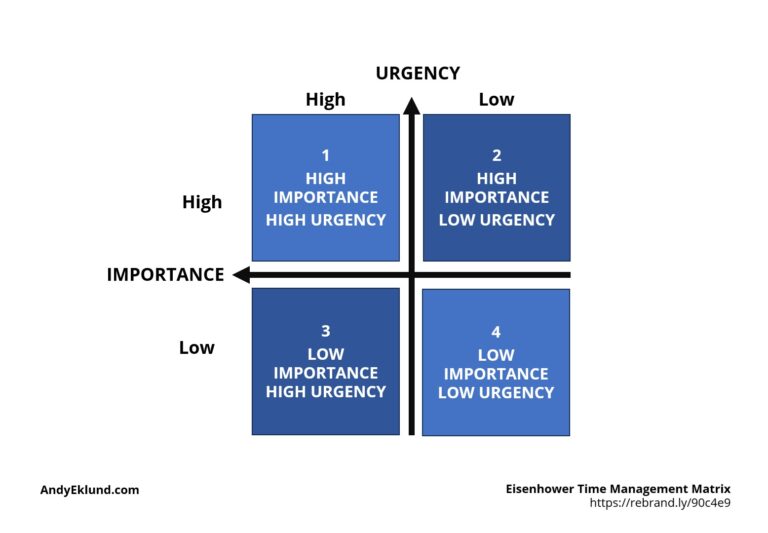
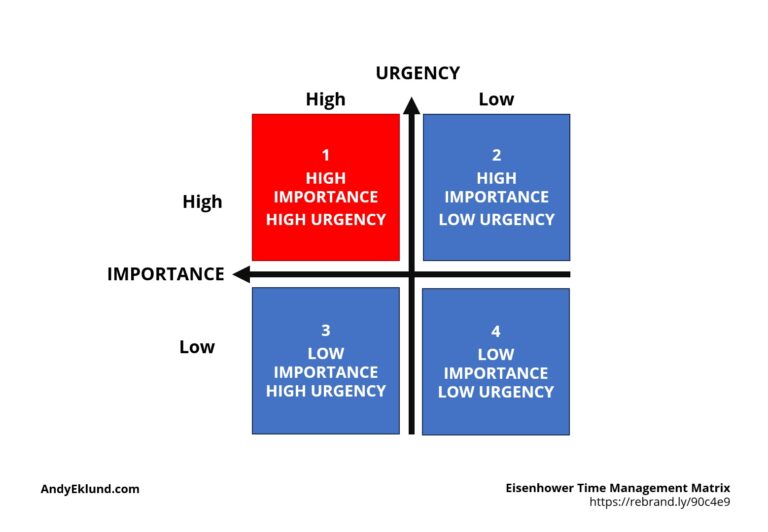
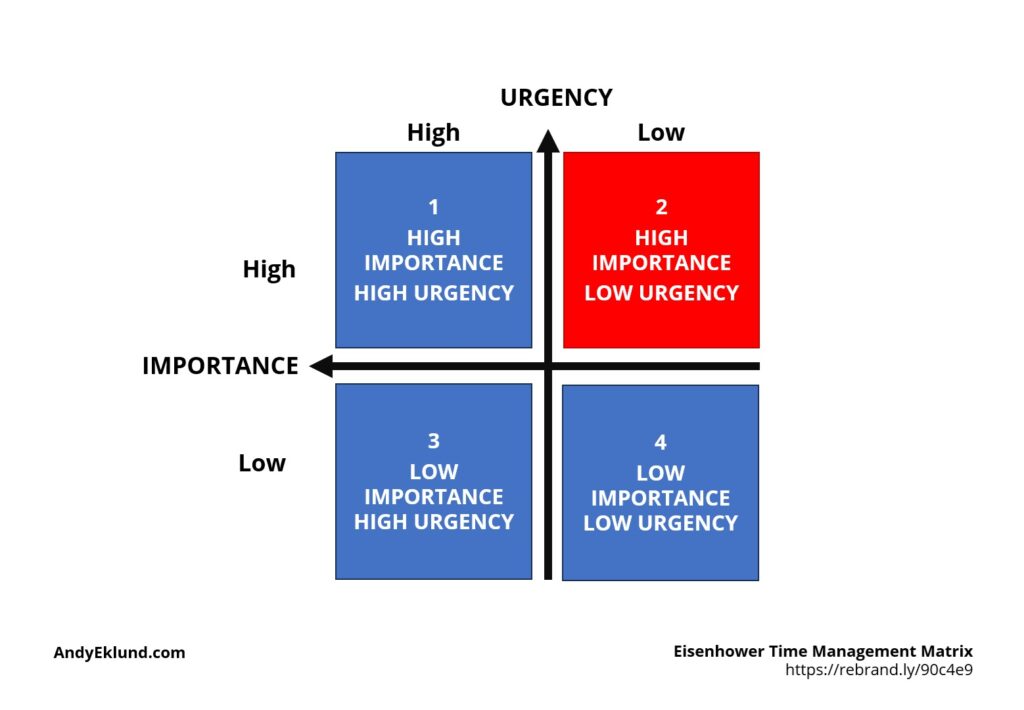
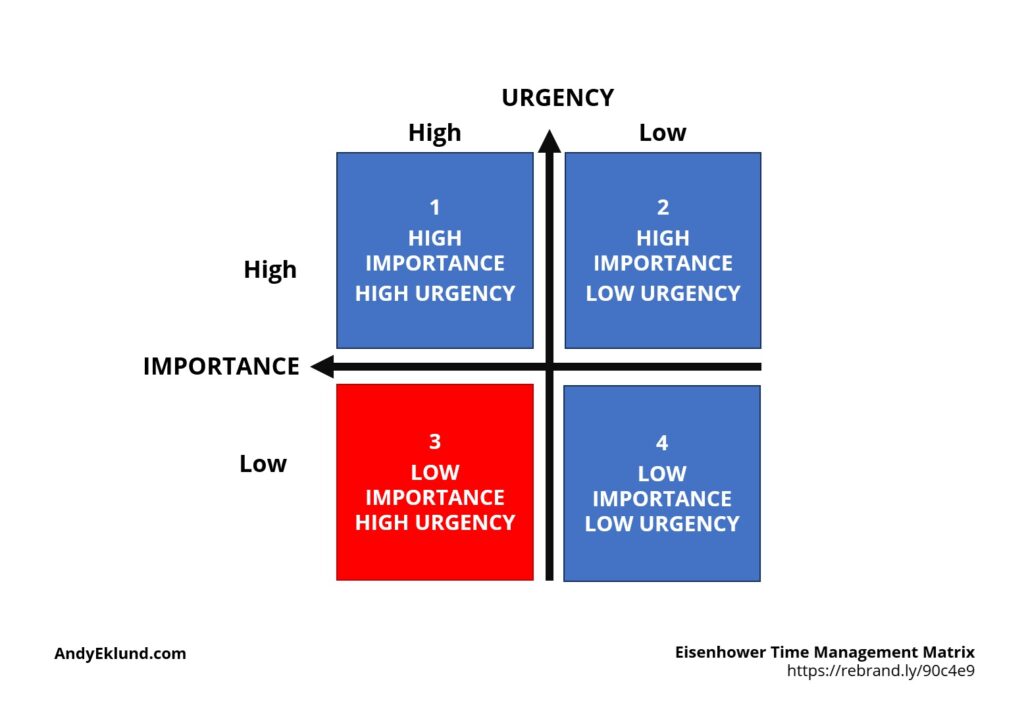
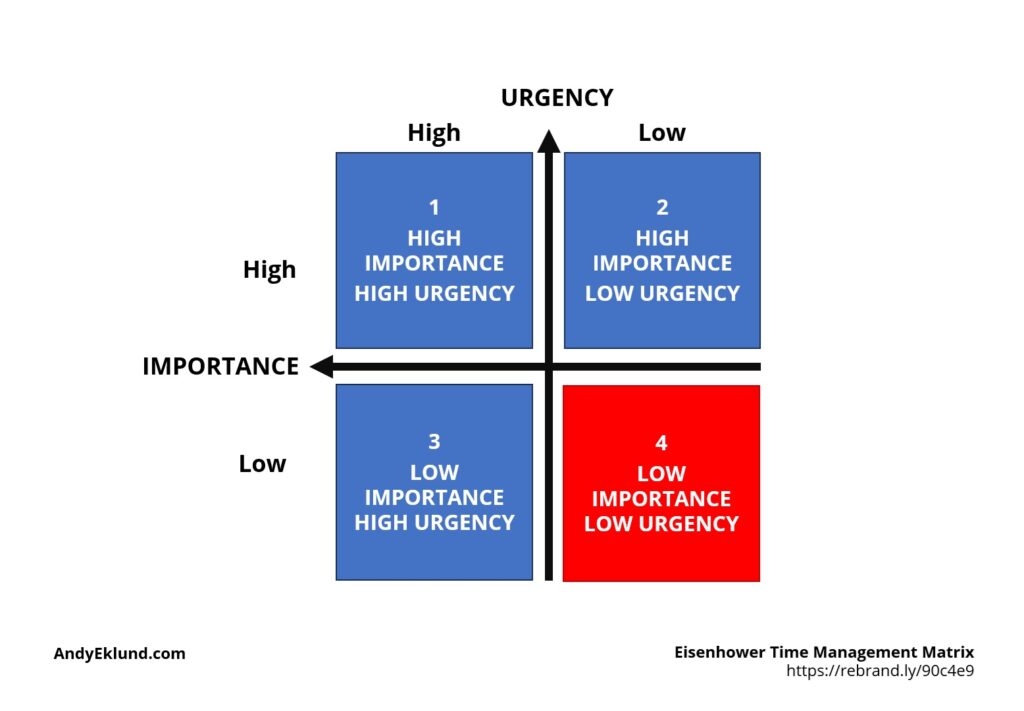

No comment yet, add your voice below!